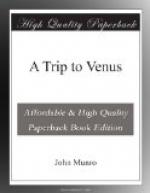“Oh, how lovely!” exclaimed Miss Carmichael, looking through the glass. “The bigger star is a golden or topaz yellow, and the smaller a light sapphire blue.”
“Some of the star groups and nebulae are just as pretty,” observed Gazen, turning his telescope to another part of the heavens; “most of the stars are white, but there is a sprinkling of yellow, blue, and red amongst them—I mean, of course, to our view, for the absorption of our atmosphere alters the tint.”
“Does that mean that there is more youth than age, more life than death, in the universe?” enquired Miss Carmichael.
“Not exactly,” replied the astronomer. “There is apparently no lack of vigour in the Cosmos—no great sign of decrepitude; but we must remember that we see the younger and brighter stars better than the others, and for aught we know there are many dark suns or extinct stars, as well as planets and their satellites. I should not like to say that the population of space is going down; but on the whole it may be stationary. I wish I could show you the cluster in Toucan, a rosy star in a ring of white ones.”
“Like a brooch of pearls,” said Miss Carmichael.
“Yes—not unlike that,” responded Gazen, evidently amused at her comparison. “But that constellation is in the Southern Hemisphere. However, here is the ‘ring’ or ‘planetary’ nebula in the Lyre.”
“What a wonderful thing!” exclaimed Miss Carmichael, with her eye at the instrument. “It looks to me like a golden hoop, with diamond dust inside.”
I do not know where Miss Carmichael got her knowledge of jewellery, for to all appearance she wore none.
“Or the cup of a flower,” she added, raising her head.
“Poets have called the stars ‘fleurs de ciel,’” said Gazen, shifting the telescope, “and if so, the nebula are the orchids; for they imitate crabs, birds, dumb-bells, spirals, and so forth. Take a look at this one, and tell us what you think of it.”
“I see a cloud of silver light in the dark sky,” said Miss Carmichael, after observing it.
“What does it resemble?”
“It’s rather like a pansy—or—”
“Anything else?”
“A human face!”
“Not far out,” rejoined Gazen. “It is called the Devil Nebula!”
“And what is it?” enquired Miss Carmichael.




